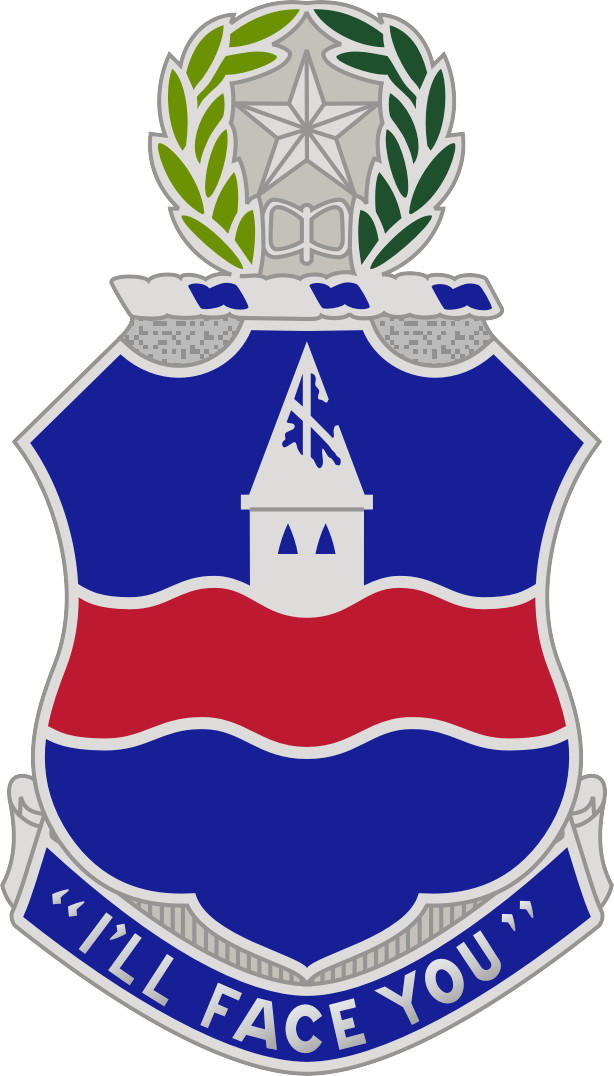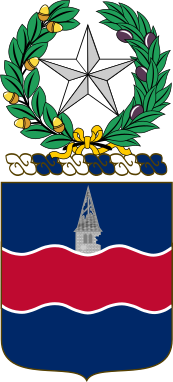About 2nd Battalion, 142nd Infantry Regiment2nd Battalion, 142nd Infantry Regiment
MOTTO: "I'll Face You!" The unit motto is based on an incident along the Aisne (Ayn River) in 1918 when a young lieutenant of the 142d under fire refused to turn his back on the enemy as his unit came back across the river after patrolling behind enemy lines.
The 142d Infantry came into existence officially on October 15, 1917, at Camp Bowie, Texas, when the 7th Texas and 1st Oklahoma Infantry Regiments were consolidated. The Oklahoma Unit had been in existence since the Spanish American War, and the Seventh Texas had been formed during the summer of 1917.
The 142d served as part of the 71st Infantry Brigade in World War I, part of the French 4th Army, and entered the forward battle area in early October 1917. The 142d led the brigade forward into positions near St. Etienne, whose ruined church tower today serves as an element of the regimental crest. In Mid October the regiment attacked toward the line of the Aisne River that advanced the American Line and eliminated a German salient south of the Aisne. In late October 1918, the regiment participated in the fighting at Foret Farm, the regiment's last fighting assignment in World War I. Seventy percent of the officers and fifty-seven percent of the enlisted men were killed or wounded during the war.
The unit was mobilized for World War II at Fort Worth, Texas on November 25, 1940 and sailed from New York to North Africa on 13 April 1943. In 1943 and early 1944 the regiment made an amphibious assault at Paestum near Salerno Italy, the first landing by U.S. forces in Europe; led fighting in the Naples-Foggia campaign; captured Manna Far; and suffered heavy loses in close combat trying to storm Albaneta Farm. In May 1944 the regiment joined with the 141 and 143 and made a second amphibious landing at Anzio, reinforcing the Fifth Army. The 142d Regiment made a third amphibious assault on Southern France in August 1944. Later in that month, the 142 captured Remiremont on the Moselle. The regiment battled through the foothills of the Vosges Mountains including the Battle for Bruyeres in October, the Foret Domaniale de Champ in November and entered the Alsatian Plains by forcing Ste Marie Pass in late November 1944. The 142d Infantry fought the battle of Oberhoffen in February 1945, and later crossed the Zintzel River at Mertzewiller against determined German resistance. Mopping up pillboxes and strongholds west of the Rhine in March, the Regiment reached the Rhine itself in March 1945.
With the 141st, the 142d led the division's attack across the Lecht River in the Danube plain in April 1945 and then followed in the wake of the 10th Armored Division from Landsberg to take Bad Toelz on 1 May with the 141st in the lead. On 5 May 1945 members of the 142nd arrived as reinforcements and tipped the Battle for Castle Itter in favor of a combined U.S. Army/Wehrmacht defense against a Waffen SS attack, the only time German and American forces fought side-by-side in World War II. It ended the war in the Kufstein area of Austria when hostilities were declared ended on 7 May 1945. The unit was returned to the United States on December 15, 1945 and was inactivated at Camp Patrick Henry, Virginia, on that date.
The 142nd Infantry Regiment was reactivated as a component of the 36th Infantry Division on 23 October 1946.
Distinctive Unit Insignia:

Taken from the shield portion of the unit’s coat of arms, the 142nd Distinctive Unit Insignia celebrates the Regiment’s contributions to the 36th Division’s World War I success. The shield’s blue background is for Infantry, and the wavy band (“fess”) in the middle is a symbol of the Aisne river where the Regiment fought in the war; it also represents the Red River which separates Texas and Oklahoma, the states from which the units were drawn when it was formed. A church steeple recalls a chapel in St. Etienne in France, again an area where the Regiment saw action. At the bottom, the motto “I’ll Face You” is taken from the account of a Reconnaissance patrol leader who, after securing vital intelligence for his superiors, would not turn his back to the Germans while making his way to headquarters, instead facing the enemy and yelling this phrase.
Coat of Arms:

Blazon:
Shield: Azure, a fess wavy Gules fimbriated Argent, issuant in chief the shell-torn church steeple at St. Etienne, France, of the third.
Crest: That for the regiments and separate battalions of the Texas Army National Guard: On a wreath of the colors Argent and Azure, a mullet Argent encircled by a garland of live oak and olive Proper.
Symbolism:
The shield is blue for Infantry. The wavy fess symbolizes the Aisne River, where the regiment's outstanding achievements took place during World War I; it also symbolizes the Red River separating the States of Texas and Oklahoma, from which states were drawn the units composing the 142d Infantry, Texas Army National Guard – the 7th Texas and Machine Gun Company. The church at St. Etienne, France, was in the sector where the regiment received its baptism of fire.